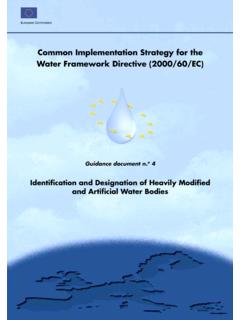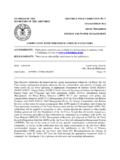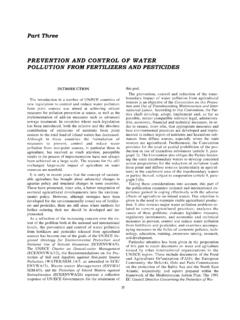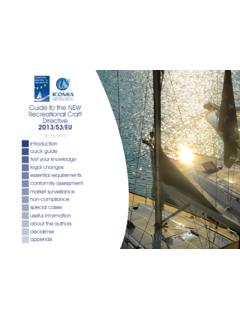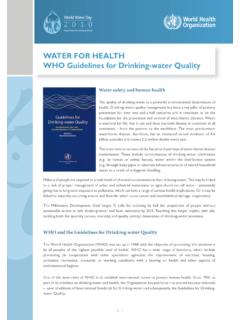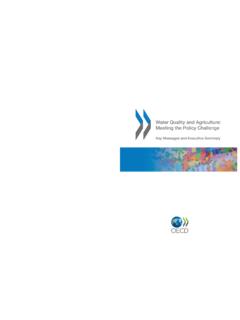Transcription of European Commission (DG ENV)
1 Contact BIO Intelligence Service Shailendra Mudgal Patricia Benito TEL + 33 (0) 1 56 20 28 98 Reference: 070307/2008/5208889/ETU/D2 STUDY ON water EFFICIENCY STANDARDS Final Report July, 2009 European Commission (DG ENV)In association with 070307/2008/5208889/ETU/D2 FICIENCY European Commission (DG ENV) 2 European Commission (DG ENV) Study on water efficiency standards July 2009 Project Team Bio Intelligence Service Mr. Shailendra Mudgal Ms. Patricia Benito Mr. Vincent Jean-Baptiste Ms. D bora Dias Ms. Mary Ann Kong Cranfield University Mr. David Inman Ms. Melanie Muro Suggested citation for this report: Patricia Benito, Shailendra Mudgal, D bora Dias, Vincent Jean-Baptiste, Mary Ann Kong, David Inman, Melanie Muro.
2 water Efficiency Standards. Bio Intelligence Service and Cranfield University, Report for European Commission (DG Environment), 2009. Disclaimer: The project team does not accept any liability for any direct or indirect damage resulting from the use of this report or its content. This report contains the results of research by the authors and is not to be perceived as the opinion of the European Commission . July 2009 European Commission (DG ENV) Study on water efficiency standards 3 Table of Contents Executive summary 7 Abbreviations 13 1. General background 15 Report structure 15 water scarcity in Europe: a growing concern 16 water consumption in Europe 16 Policy action in the EU 19 Improving efficiency in water use 22 2.
3 Study objectives and methodology 25 Objectives of the study 25 Approach and methodology 25 Key definitions 28 3. Product scope and classification 31 water use in buildings 32 water use in industry 112 water use in Agriculture 133 Prioritistation of WuPs 145 Chapter key elements 146 4. Review of existing standards 149 Introduction 149 Existing water efficiency policy measures 150 Desk study 26 Stakeholder consultation 26 Information processing and analysis 27 water -using product 28 water efficiency 28 Building, agriculture, and industry sectors 29 Outlook of water use in buildings 32 Scope definition 39 Categories definition 40 water performance assessment of WuPs in buildings 83 Outlook of water use in industry 112 Scope definition 114 Categories definition 116 water performance assessment of WuPs in industry 128 Outlook of water use in agriculture 133 Scope definition 139 4 European Commission (DG ENV)
4 Study on water efficiency standards July 2009 Policy measures at the EU level 152 Policy measures at Member State level 154 Policy measures in third countries 166 Technical and test standards and product testing procedures 180 Chapter key elements 189 5. Impacts of existing policies 190 Introduction 191 Assessment approach 192 Characterisation of policy measures and indicators selection 194 Analysis of existing instruments - gaps and inconsistencies 203 Outcomes and impacts of identified measures 205 Best practices 228 Comparative analysis of benefits and limitations 230 Chapter key elements 234 6. Assessment of the need for an EU approach 235 Introduction 235 Need for an EU approach 236 Mandatory measures 152 Voluntary measures 153 Mandatory measures 154 Voluntary measures 159 Other initiatives in Member States 165 Mandatory measures 166 Voluntary measures 172 European (EN) standards 181 Country-specific technical and test standards 184 Other sector-specific procedures for product testing 188 Regulatory measures 195 Information measures 198 Voluntary agreements 200 Mandatory measures outcomes, impacts, barriers 205 Labels 208 Voluntary measures outcomes, impacts, and barriers 210 Analysis of best practice case studies 228 Lessons to be learned 229 Regulation vs.
5 Information instruments 230 Voluntary vs. mandatory instruments 231 Ranking vs. endorsement 231 Single issue vs. multiple issues 232 Single instrument vs. policy-mixes 232 July 2009 European Commission (DG ENV) Study on water efficiency standards 5 Policy options and their pros and cons 240 Identification and prioritisation of water -using products for EU action 256 Chapter key elements 259 7. Conclusions and recommendations 261 Conclusions 261 Recommendations 264 8. References 269 9. Appendices 285 Appendix 1: Overview of basic policy measures and corresponding sub-categories 285 Appendix 2: Fact sheets of different schemes at the EU and Member State level 287 Appendix 3: Fact sheets of different schemes in third countries 298 Appendix 4: Best practice case studies 309 Are today s MS actions enough to tackle the problem?
6 236 Added value of EU action 237 What approach or type of action would be more feasible and efficient? 239 Analysis of options 243 water consumption 256 Intrinsic water saving potential 257 Market trends 258 Interaction with existing EU actions 258 Coverage and effectiveness of existing schemes 259 Existing schemes and measures addressing water efficiency 261 Benefits and limitations of existing schemes and measures 261 Need for an EU approach 262 Recommendations for an EU approach 264 prioritisation of water -using products 265 Introducing new specifications 266 Study limitations and Future work 266 6 European Commission (DG ENV) Study on water efficiency standards July 2009 This page is left intentionally blank July 2009 European Commission (DG ENV)
7 Study on water efficiency standards 7 EXECUTIVE SUMMARY Background water scarcity and droughts affect many parts of Europe. Climate change and population growth are predicted to make the existing water problems even worse in many regions. In recognition of the acuteness of water scarcity and drought challenges, the European Union has adopted a Communication addressing the challenge of water scarcity and droughts. The Communication provides a fundamental and well-developed first set of policy options for future action, within the framework of EU water management principles, policies, and objectives. The Commission is exploring the ways in which the European Union can address water scarcity and droughts and a number of recommendations were made in the Communication in this regard.
8 Amongst the various identified policy options, one of them suggests analysing the potential of water efficiency standards for water -using Products (WuPs) at EU level. This option needs further assessment in terms of feasibility and implementation, which is the subject of this study. Objectives and methodology This study aims to analyse the need for introducing water efficiency standards for water -using devices at the EU level and to discuss the potential advantages and disadvantages of such an approach based on existing evidence in EU Member States (MS) and beyond. Stakeholder consultation was carried out targeting MS and other relevant stakeholders to collect information on existing specific regulations or programmes at the national or sub-national levels within and outside Europe, which introduce water efficiency requirements.
9 This was achieved through a dedicated questionnaire and a website. A number of interviews were also conducted with a range of experts and other key stakeholders ( research institutes). A desk study of existing relevant publications and internet sources was also carried out. Identification of WuPs and classification The first step was to provide a general definition of a WuP, followed by the development of a list of WuPs for different sectors (buildings, industry, and agriculture), and their prioritisation of WuPs. Based on whether the product is widely used in the EU, and its use patterns, potential for improvement, water efficiency, and market trends, prioritisation was needed for a number of different products in the household sector in Europe.
10 The most important products are those used for sanitation, laundry, washing and outdoor applications. In particular, it was estimated that WCs, showers, taps, washing machines, and dishwashers contribute to 31%, 33%, 10%, 11%, and 3% of average household water use respectively. On the other hand, 8 European Commission (DG ENV) Study on water efficiency standards July 2009 outdoor water consumption ( garden irrigation, cleaning equipment) represents approximately 3% of average household water use. In terms of water saving potential, by reducing current stock with more efficient products, dishwashers represent the greatest potential of 55%, followed by toilets of 53% (including both long and short flushes), and washing machines of 32%.










